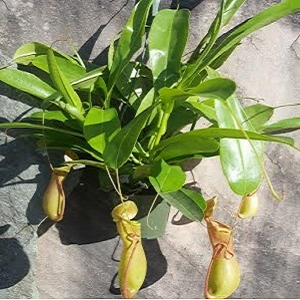Nepenthes carnivorous pitcher plant eats insects including ants, wasps, flies and similar size bugs. It sounds a bit gross but it actually its an interesting process that is unique to carnivorous plants and a great way to get rid of pests (mosquitos). There are many variations of pitcher plants and variations of Nepenthes bug plants but all have the same basic way of obtaining nutrient. They can eat just about any insect that slips its way into the pitcher from flies to roaches.
The process begins by the pitcher bug eating plants giving off a vibrant pitcher color that attracts the insects from far and as they get closer the pitchers have a nectar that further helps attract the insect. As the insect reaches the peristome (larger thick ring at top of pitcher) it goes to eat the nectar and becomes stuck to the pitcher. Inside the pitcher there is a slippery nectar which the bug begins to slip down. The upper section is called the conductive/ retentive zone and the lower section of the Nepenthes carnivorous pitcher plant is known as the digestive zone.
When the bug reaches the digestive zone in the bug plant, it begins to be broken down and digested the insect in the pitcher. The carnivorous plant takes anywhere from a week to two months to fully digest a bug. It is not difficult to notice where the pitcher zone difference is because there will be browning in this area especially if the pitcher has too many bugs.
Once in the digestive zone the Nepenthes pitcher walls give off enzymes which break down the insect to digest it. The bugs never digest one hundred percent to where there are no remains. You may always see bug parts in your Nepenthes pitcher plant until the life of the pitcher is over.
At this point the nutrients enters through the tendril which is the thin vine that connects to the pitcher plants leave. This is how carnivorous plant, Nepenthes pitcher plants, get all their nutrient from which is why it does not need plant food or fertilizer which most the time will end up harming and killing you carnivorous plant.


